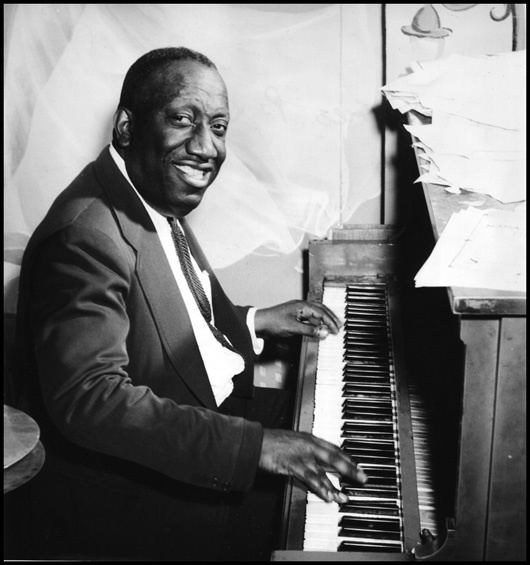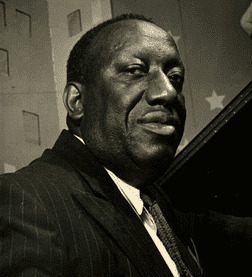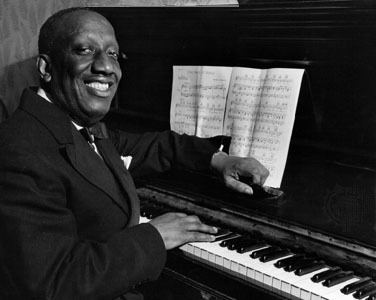Birth name James Price Johnson Name James Johnson Occupation(s) Composer, musician Role Composer | Instruments Piano Years active 1912–1955 | |
 | ||
Albums Harlem Stride Piano: 1921-1929, Early Harlem Piano Similar People Fats Waller, Willie "The Lion" Smith, Jelly Roll Morton, Earl Hines, Fletcher Henderson | ||
carolina shout james p johnson
James Price Johnson (February 1, 1894 – November 17, 1955) was an American pianist and composer. A pioneer of the stride style of jazz piano, he was one of the most important pianists who bridged the ragtime and jazz eras, and, with Jelly Roll Morton, one of the two most important catalysts in the evolution of ragtime piano into jazz. As such, he was a model for Count Basie, Duke Ellington, Art Tatum, and Fats Waller.
Contents
- carolina shout james p johnson
- James p johnson if i could be with you one hour tonight
- Biography
- Composer
- Pianist
- Legacy
- Honors and recognitions
- Film scores
- Album discography
- CD re issues
- References

Johnson composed many hit tunes including the theme song of the Roaring Twenties; "Charleston" and "If I Could be With You One Hour Tonight" and remained the acknowledged king of New York jazz pianists through most of the 1930s. Johnson's artistry, his significance in the subsequent development of jazz piano, and his large contribution to American musical theatre, are often overlooked, and as such, he has been referred to by Reed College musicologist David Schiff, as "The Invisible Pianist".

James p johnson if i could be with you one hour tonight
Biography
Johnson was born in New Brunswick, New Jersey, United States. The proximity to New York City meant that the full cosmopolitan spectrum of the city's musical experience, from bars, to cabarets, to the symphony, were at the young Johnson's disposal. Johnson's father, William H. Johnson, was a store helper and mechanic while his mother, Josephine Harrison was a maid. Harrison was a part of the choir at the Methodist Church and was also a self-taught pianist. Johnson later attributed the popular African-American songs and dances at home and around the city as early influences on his musical taste. In 1908, Johnson's family moved to the San Juan Hill (near where Lincoln Center stands today) section of New York City and subsequently moved again to uptown in 1911. With perfect pitch and excellent recall he was soon able to pick out on the piano tunes that he had heard.
Johnson grew up listening to the ragtime of Scott Joplin and always retained links to the ragtime era, playing and recording Joplin's "Maple Leaf", as well as the more modern (according to Johnson) and demanding, "Euphonic Sounds", both several times in the 1940s. Johnson, who got his first job as a pianist in 1912, decided to pursue his musical career rather than return to school. From 1913 to 1916 Johnson spent time studying the European piano tradition with Bruto Giannini. Over the next four to five years Johnson continued to progress his ragtime piano skills by studying other pianists and composing his own rags.
In 1914, while performing in Newark, New Jersey with singer Lillie Mae Wright, who became his wife three years later, Johnson met Willie Smith. Smith and Johnson shared many of the same ideas regarding entertainers and their stage appearance. These beliefs and their complementary personalities led the two to become best friends. Starting in 1918, Johnson and Wright began touring together in the Smart Set Revue before settling back in New York in 1919.
Before 1920 Johnson had gained a reputation as a pianist on the East coast on a par with Eubie Blake and Luckey Roberts and made dozens of player piano roll recordings initially documenting his own ragtime compositions before recording for Aeolian, Perfection (the label of the Standard Music Roll Co., Orange, NJ), Artempo (label of Bennett & White, Inc., Newark, NJ), Rythmodik, and QRS during the period from 1917 to 1927. During this period he met George Gershwin, who was also a young piano-roll artist at Aeolian.
Johnson was a pioneer in the stride playing of the jazz piano. "Stride piano has often been described as an orchestral style and indeed, in contrast to boogie-woogie blues piano playing, it requires a fabulous conceptual independence, the left hand differentiating bass and mid-range lines while the right supplies melodic issues." Johnson honed his craft, playing night after night, catering to the egos and idiosyncrasies of the many singers he encountered, which necessitated being able to play a song in any key. He developed into a sensitive and facile accompanist, the favorite accompanist of Ethel Waters and Bessie Smith. Ethel Waters wrote in her autobiography that working with musicians such as, and most especially, Johnson "...made you want to sing until your tonsils fell out".
As his piano style continued to evolve, his 1921 phonograph recordings of his own compositions, "Harlem Strut", "Keep Off the Grass", and "Carolina Shout", were, along with Jelly Roll Morton's Gennett recordings of 1923, among the first jazz piano solos to be put onto record. Johnson seemed to be at his finest when he attacked the piano as if it were a drum set. These technically challenging compositions would be learned by his contemporaries, and would serve as test pieces in solo competitions, in which the New York pianists would demonstrate their mastery of the keyboard, as well as the swing, harmonies, and improvisational skills which would further distinguish the great masters of the era.
The majority of his phonograph recordings of the 1920s and early 1930s were done for Black Swan (founded by Johnson's friend W.C. Handy, where William Grant Still served in an A&R capacity) and Columbia. In 1922, Johnson branched out and became the musical director for the revue Plantation Days. This revue took him to England for our months in 1923. During the summer of 1923 Johnson, along with the help of lyricist Cecil Mack, wrote the revue Runnin' Wild. This revue stayed on tour for more than five years as well as showing on Broadway.
In the depression era, Johnson's career slowed down somewhat. As the swing era began to gain popularity within the African-American communities, Johnson had a hard time adapting and his music would ultimately become unpopular. The cushion of a modest but steady income from his composer's royalties allowed him to devote significant time to the furtherance of his education, as well as the realization of his desire to compose "serious" orchestral music. Johnson began to write for musical revues and composed many forgotten orchestral music pieces. Although by this time he was an established composer, with a significant body of work, as well as a member of ASCAP, he was nonetheless unable to secure the financial support that he sought from either the Rosenwald Foundation, or a Guggenheim Fellowship, both of which he received endorsement for from the Columbia Records executive, and long time admirer, John Hammond. The Johnson archives include the letterhead of an organization called "Friends of James P. Johnson", ostensibly founded at the time (presumably in the late 1930s) in order to promote his then-idling career. Names on the letter-head include Paul Robeson, Fats Waller, Walter White (President of the NAACP), the actress Mercedes Gilbert and Bessye Bearden, the mother of artist Romare Bearden. In the late 1930s Johnson slowly started to re-emerge with the revival of interest in traditional jazz and began to record, with his own and other groups, at first for the HRS label. Johnson's appearances at the Spirituals to Swing concerts at Carnegie Hall in 1938 and 1939 were organized by John Hammond, for whom he recorded a substantial series of solo and band sides in 1939.
Johnson suffered a stroke (likely a transient ischemic attack) in August 1940. When Johnson returned to action, in 1942, he began a heavy schedule of performing, composing, and recording, leading several small live and groups, now often with racially integrated bands led by musicians such as Eddie Condon, Yank Lawson, Sidney de Paris, Sidney Bechet, Rod Cless, and Edmond Hall. In 1944, Johnson and Willie Smith participated in stride piano contests in Greenwich Village from August to December. He recorded for jazz labels including Asch, Black and White, Blue Note, Commodore, Circle, and Decca. In 1945, Johnson performed with Louis Armstrong and heard his works at Carnegie Hall and Town Hall. He was a regular guest star and featured soloist on Rudi Blesh's This is Jazz broadcasts, as well as at Eddie Condon's Town Hall concerts and studied with Maury Deutsch, who could also count Django Reinhardt and Charlie Parker among his pupils.
In the late 1940s, Johnson had a variety of jobs, including jam sessions at Stuyvesant Casino and Central Plaza, as well as becoming a regular on Rudi Blesh's radio show. In 1949 as an 18-year-old, actor and band leader Conrad Janis put together a band of aging jazz greats, consisting of James P. Johnson (piano), Henry Goodwin (trumpet), Edmond Hall (clarinet), Pops Foster (bass) and Baby Dodds (drums), with Janis on trombone. Johnson permanently retired from performing after suffering a severe, paralyzing stroke in 1951. Johnson survived financially on his songwriting royalties while he was paralyzed. He died four years later in Jamaica, New York and is buried in Mount Olivet Cemetery in Maspeth, Queens. Perfunctory obituaries appeared in even The New York Times. The pithiest and most angry remembrance of Johnson was written by John Hammond and appeared in Down Beat under the title "Talents of James P. Johnson Went Unappreciated".
Composer
Johnson composed many hit tunes in his work for the musical theatre, including "Charleston" (which debuted in his Broadway show Runnin' Wild in 1923, although by some accounts Johnson had written it years earlier, and which became one of the most popular songs of the "Roaring Twenties"), "If I Could Be With You (One Hour Tonight)", "You've Got to Be Modernistic", "Don't Cry, Baby", "Keep off the Grass", "Old Fashioned Love", "A Porter's Love Song to a Chambermaid", "Carolina Shout", and "Snowy Morning Blues". He wrote waltzes, ballet, symphonic pieces and light opera; many of these extended works exist in manuscript form in various stages of completeness in the collection of Johnson's papers housed at the Institute of Jazz Studies, Rutgers University, Newark, New Jersey. Johnson's success as a popular composer qualified him as a member of ASCAP in 1926.
1928 saw the premier of Johnson's rhapsody Yamekraw, named after a black community in Savannah, Georgia. William Grant Still was orchestrator and Fats Waller the pianist as Johnson was contractually obliged to conduct his and Waller's hit Broadway show Keep Shufflin. Harlem Symphony, composed during the 1930s, was performed at Carnegie Hall in 1945 with Johnson at the piano and Joseph Cherniavsky as conductor. He collaborated with Langston Hughes on the one-act opera, De Organizer. A fuller list of Johnson's film scores appears below.
Pianist
Along with Fats Waller and Willie 'The Lion' Smith ('The Big Three'), and Luckey Roberts, Johnson embodies the Harlem Stride piano style, an evolution of East Coast ragtime infused with elements of the blues. His "Carolina Shout" was a standard test piece and rite of passage for every contemporary pianist: Duke Ellington learned it note for note from the 1921 QRS Johnson piano roll. Johnson taught Fats Waller and got him his first piano roll and recording assignments.
Harlem Stride is distinguished from ragtime by several essential characteristics: ragtime introduced sustained syncopation into piano music, but stride pianists built a more freely swinging rhythm into their performances, with a certain degree of anticipation of the left (bass) hand by the right (melody) hand, a form of tension and release in the patterns played by the right hand, interpolated within the beat generated by the left. Stride more frequently incorporates elements of the blues, as well as harmonies more complex than usually found in the works of classic ragtime composers. Lastly, while ragtime was for the most part a composed music, based on European light classics such as marches, pianists such as Waller and Johnson introduced their own rhythmic, harmonic and melodic figures into their performances and, occasionally, spontaneous improvisation. As the second generation stride pianist Dick Wellstood noted, in liner notes for the stride pianist Donald Lambert, most of the stride pianists of the 1920s, 1930s and 1940s were not particularly good improvisers. Rather, they would play their own, very well worked out, and often rehearsed variations on popular songs of the day, with very little change from one performance to another. It was in this respect that Johnson distinguished himself from his colleagues, in that (in his own words), he "could think of a trick a minute". Comparison of many of Johnson's recordings of a given tune over the years demonstrates variation from one performance to another, characterised by respect for the melody, and reliance upon a worked out set of melodic, rhythmic, and harmonic devices, such as repeated chords, serial thirds (hence his admiration for Bach), and interpolated scales, on which the improvisations were based. This same set of variations might then appear in the performance of another tune.
Legacy
James P. Johnson may be thought of as the last major pianist of the classic ragtime era, and, the first major jazz pianist, and, therefore, as an indispensable bridge between ragtime and jazz. Johnson's musical legacy is also present in the body of work of his pupil, the more famous Fats Waller as well as scores of other pianists who were influenced by him, such as Art Tatum, Donald Lambert, Louis Mazetier, Pat Flowers, Cliff Jackson, Hank Duncan, Claude Hopkins, Duke Ellington, Count Basie, Don Ewell, Johnny Guarnieri, Dick Hyman, Dick Wellstood, Ralph Sutton, Joe Turner, Neville Dickie, Mike Lipskin, and Butch Thompson.
Honors and recognitions
Two Romare Bearden paintings bear the name of Johnson compositions: Carolina Shout, and Snow(y) Morning.
On September 16, 1995 the U.S. Post Office issued a James P. Johnson 32-cent commemorative postage stamp.
Unmarked since his death in 1955, his grave was re-consecrated with a headstone paid for with funds raised by an event arranged by the James P. Johnson Foundation, Spike Wilner and Dr. Scott Brown on October 4, 2009.
Film scores
Johnson's compositions as film scores were used in a number of movies, which were compiled from previously written musical compositions. A partial list includes:
Album discography
CD re-issues
Multiple CDs of Johnson's recordings have been reissued. The French Chronological Classics series includes six discs devoted to Johnson. The Decca CD, Snowy Morning Blues, contains 20 sides done for the Brunswick and Decca labels, between 1930 and 1944. This CD includes an eight-tune Fats Waller Memorial set, and two solos, "Jingles", and "You've Got to be Modernistic", which demonstrate Johnson's hard swinging stride style. The LP, and CD, Father of the Stride Piano, collects some of Johnson's best recordings for the Columbia family of labels, done between 1921 and 1939. It includes "Carolina Shout", "Worried and Lonesome Blues", and "Hungry Blues" (from De Organizer).
Johnson's complete Blue Note recordings (solos, band sides in groups led by himself as well as Edmond Hall and Sidney DeParis) were issued in a collection by Mosaic Records. The largest anthology of Johnson's recordings was compiled in the Giants of Jazz series by Time-Life Music. This three-LP collection contains 40 sides recorded from 1921 to 1945, and is supplemented with extensive liner notes, including a biographical essay by Frank Kappler, and criticism of the musical selections by Dick Wellstood, and the musicologist, Willa Rouder. Many of Johnson's approximately 60 piano rolls, recorded between 1917 and 1927, have been issued on CD on the Biograph Label. A book of musical transcriptions of Johnson's piano roll performances of his own compositions has been prepared by Dr. Robert Pinsker, to be published through the auspices of the James P. Johnson Foundation.
